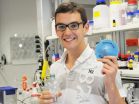(Press-News.org) Roughly 780 million people around the world have no access to clean drinking water. According to the World Health Organization (WHO), 3.4 million people die from water-related diseases every year. ETH student Jeremy Nussbaumer set himself the goal of making a contribution to solving this problem. Working with researchers from a group led by Wendelin Stark, head of the Functional Materials Laboratory, the 23-year-old spent a year researching a membrane filter and developing a prototype.
"What makes our DrinkPure filter unique is that you can screw it on to virtually any plastic bottle. It doesn't require a pump or a reservoir, so it's very easy to use," explains the student from the canton of Aargau. "You simply screw the filter onto a bottle containing polluted water, then you can put it straight in your mouth and take a drink." Weighing less than 100 grams, DrinkPure is considerably lighter than most other filters, and the flow pressure is so high that you can purify as much as a litre of water in a minute just by squeezing the bottle with your hand. Another benefit is that the unit is less expensive and easier to manufacture than most conventional filters. These qualities, says Nussbaumer, make the filter ideal for development aid projects.
Three-Stage Filter System With Special Membrane
Three filtering stages make DrinkPure one of the most reliable devices currently on the market. First, a pre-filter captures large particles such as sand and plant fragments; the second stage consists of an activated charcoal powder that primarily removes undesirable odours and chemical contaminants; the third and most important part of the filter is a polymer membrane that removes bacteria. In fact, this membrane does its job more reliably than virtually any other water filter intended for outdoor use.
Two ETH doctoral students developed this polymer membrane and patented it three years ago. It is based on a new manufacturing process that shows great potential. It has been used in a wide range of other applications since then – for example, in a non-toxic outdoor jacket (as reported in ETH News) and its use as a battery separator is also being investigated.
First Filters to Africa Next January
A year ago, Nussbaumer learned of the project to further develop this membrane for use in a water filter. The mechanical engineering student was so enthusiastic about the idea that after completing his bachelor's degree, he decided to postpone his master's degree for a year in order to devote himself to this project. "I was really looking forward to finally being able to do something tangible and useful. Of course, we hoped that the membrane would prove suitable for a water filter, but we never expected such excellent test results," says Nussbaumer proudly.
In order that the research team can manufacture enough filters to use in developing countries, they are looking for financial support. They will use the proceeds to purchase the tools they need to manufacture the filters. "As for what is left over, we will use 80% to produce the filter and transport it to Africa and 20% to further develop the concept," says Nussbaumer. They expect to have the first filters completed in January 2015; they will be sent to project supporters and to Africa for use in a test phase.
Perfect for Travellers and Walkers
It is still not certain whether DrinkPure will be available in future in retail stores. Alongside its suitability for development aid, the device is also perfect for travellers and walkers. "Quickly screw it on a bottle and you can take a drink from any pond or river without a second thought," explains Nussbaumer. "I'm actually not a serious walker myself, but if I were to go I would be sure to take the filter along."
Crowdfunding
The project is presented by the young research team on the Indiegogo platform. Investors can support the project with an amount ranging from 5 to 5,000 US dollars. Depending on the contribution, a donor can expect various perks, such as a thank-you video from the project leader. With a contribution of 89 dollars, a backer receives a filter and for 500 dollars, 10 units will be sent to Africa. Anyone can support the project until 20 August 2014 via the following link: http://www.indiegogo.com
INFORMATION: END
ETH student develops filter for clean water around the world
2014-07-23
ELSE PRESS RELEASES FROM THIS DATE:
Ketamine can be a wonder drug for ER patients and their physicians
2014-07-23
WASHINGTON -- For critically ill patients arriving at the emergency department, the drug ketamine can safely provide analgesia, sedation and amnesia for rapid, life-saving intubation, despite decades-old studies that suggested it raised intracranial pressure. The results of a systematic review of 10 recent studies of what many emergency physicians regard as a "wonder drug" are published online in Annals of Emergency Medicine "The Effect of Ketamine on Intracranial and Cerebral Perfusion Pressure and Health Outcomes: A Systematic Review."
"Apprehension for many years ...
Climate change and the soil
2014-07-23
Washington, DC -- The planet's soil releases about 60 billion tons of carbon into the atmosphere each year, which is far more than that released by burning fossil fuels. This happens through a process called soil respiration. This enormous release of carbon is balanced by carbon coming into the soil system from falling leaves and other plant matter, as well as by the underground activities of plant roots.
Short-term warming studies have documented that rising temperatures increase the rate of soil respiration. As a result, scientists have worried that global warming ...
AGU: Voyager spacecraft might not have reached interstellar space
2014-07-23
WASHINGTON, D.C. -- In 2012, the Voyager mission team announced that the Voyager 1 spacecraft had passed into interstellar space, traveling further from Earth than any other manmade object.
But, in the nearly two years since that historic announcement, and despite subsequent observations backing it up, uncertainty about whether Voyager 1 really crossed the threshold continues. There are some scientists who say that the spacecraft is still within the heliosphere – the region of space dominated by the Sun and its wind of energetic particles – and has not yet reached the ...
Wide-faced men negotiate nearly $2,200 larger signing bonus
2014-07-23
RIVERSIDE, Calif. -- Having a wider face helps men when they negotiate for themselves but hurts them when they are negotiating in a situation that requires compromise. Additionally, men who are more attractive are better collaborators compared to less attractive men.
Those are among the findings outlined in a just published paper co-authored by Michael P. Haselhuhn and Elaine M. Wong, assistant professors of management at the University of California, Riverside's School of Business Administration. The paper describes four negotiation simulations set up by the authors ...
This week from AGU: Oso report, rockfall in Yosemite Park, and a new ear
2014-07-23
From AGU's blogs: Oso disaster had its roots in earlier landslides
A research team tasked with being some of the first scientists and engineers to evaluate extreme events has issued its findings on disastrous Oso, Washington, landslide. The report studies the conditions and causes related to the March 22 mudslide that killed 43 people and destroyed the Steelhead Haven neighborhood in Oso, Washington. The team from the Geotechnical Extreme Events Reconnaissance (GEER) Association, funded by the National Science Foundation, determined that intense rainfall in the three ...
Protein evolution follows a modular principle
2014-07-23
This news release is available in German.
Proteins impart shape and stability to cells, drive metabolic processes and transmit signals. To perform these manifold tasks, they fold into complex three-dimensional shapes. Scientists at the Max Planck Institute for Developmental Biology in Tübingen have now discovered that proteins can be constructed of similar amino acid chains even when their three-dimensional shapes differ significantly. This suggests that the proteins that exist today arose from common precursors. Presumably, in the course of evolution they were ...
Dead body feeding larvae useful in forensic investigations
2014-07-23
VIDEO:
This image depicts Chrysomya megacephala larvae on decomposing fish.
Click here for more information.
Non-biting blow fly Chrysomya megacephala is commonly found in dead bodies and is used in forensic investigations to determine the time of death, referred to as the post mortem interval. A report of synanthropic derived form of C. megacephala from Tamil Nadu is provided for the first time based on morphological features and molecular characterization through generation ...
Study provides new perspectives on the current Clostridium difficile epidemic
2014-07-23
PASADENA, Calif., July 23, 2014 — More than 80 percent of hospitalized patients who tested positive for Clostridium difficile were tested outside the hospital or within the first 72 hours of hospitalization, suggesting that settings outside of the hospital may play key roles in the identification, onset and possible transmission of the disease, according to a new Kaiser Permanente study published today in the journal Mayo Clinic Proceedings.
The study provides new insight into the contagious and potentially deadly infection also known as C. diff, a bacterium most often ...
Nano-sized chip "sniffs out" explosives far better than trained dogs
2014-07-23
Security forces worldwide rely on sophisticated equipment, trained personnel, and detection dogs to safeguard airports and other public areas against terrorist attacks. A revolutionary new electronic chip with nano-sized chemical sensors is about to make their job much easier.
The groundbreaking nanotechnology-inspired sensor, devised by Prof. Fernando Patolsky of Tel Aviv University 's School of Chemistry and Center for Nanoscience and Nanotechnology, and developed by the Herzliya company Tracense, picks up the scent of explosives molecules better than a detection dog's ...
Statin use decreases the risk of Barrett's esophagus
2014-07-23
Bethesda, MD (July 23, 2014) — Statins, a class of drugs commonly used to lower cholesterol levels, significantly reduce a patient's risk of developing Barrett's esophagus, according to a new study in Gastroenterology1, the official journal of the American Gastroenterological Association. Obese patients experienced the greatest level of risk reduction with statin use.
"Patients who received statins had a 43 percent reduction in the odds of having Barrett's esophagus compared to non-users," said study author Hashem B. El-Serag, MD, MPH, from the Houston VA Medical Center ...



